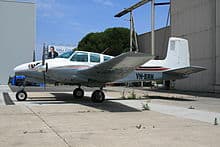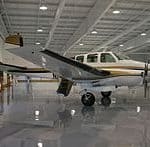
Beech Twin Bonanza 50
The Beech Twin Bonanza Model 50 is a twin-engine, piston aircraft with a retractable gear. The Model 50 is a low-wing airplane produced by Beechcraft between the years 1952 and 1963, Serial Numbers H1 through DH347. It seats up to 6 passengers and 1 pilot.
Specifications
Exterior Dimensions
Wing span: 46 ft
Length: 31 ft 7 in
Height: 11 ft 4 in
Weights
Max TO weight 6,300 LBS
Empty Weight: 4,480 LBS
Fuel capacity: 180 GAL
Engine
Manufacturer: Lycoming Motor
Model: GO-435/480
Horsepower: 260-295 HP
Overhaul (HT): 1200/1400hr TBO
Years before overhaul: 12
Performance specifications on Model 50 A, B, C, E
| Horsepower: 295.00 | Gross Weight: 6,300 |
| Top Speed: 186 | Empty Weight: 4,100 |
| Cruise Speed: 178 | Fuel Capacity: 134 |
| Stall Speed (dirty): 62 | Range: 670 |
| Rate of Climb: 1,450 | Rate of Climb (One Engine): 290 |
| Service Ceiling: 20,000 | Ceiling (One Engine): 7,000 |
| Takeoff | Landing |
| Ground Roll: 1,000 | Ground Roll 1,010 |
| Takeoff Roll Over 50 ft: 1,260 | Landing Roll Over 50 ft: 1,452 |
VIEW PERFORMANCE SPECS ON BEECH MODEL 50
VIEW PERFORMANCE SPECS ON BEECH MODEL 50E, F, G, SUPERCHARGED
VIEW PERFORMANCE SPECS ON BEECH MODEL 50H, J SUPERCHARGED
History
The Beechcraft Model 50 Twin Bonanza is a small twin-engined aircraft designed by Beechcraft as an executive transport for the business market. It was developed to fill a gap in Beechcraft's product line between the single-engined Model 35 Bonanza and the larger Model 18. The Twin Bonanza is about 50% larger than the Bonanza, has more powerful engines, and is significantly heavier, while in its earliest form having only half the passenger capacity of the Model 18.
Development
The Twin Bonanza is not a true twin-engined derivative of the Bonanza since the cabin is wider and longer, however it did use some of the tooling jigs for the Bonanza as did the Travel Air (which was a closer derivative designed later).
The Twin Bonanza was first flown on November 15, 1949 after rapid development, begun only in April of that year. The Model 50's type certificate was awarded in 1951, and production began the same year. The United States Army adopted the Twin Bonanza as the L-23 Seminole utility transport, making it the largest fixed-wing aircraft in its inventory at that time. According to Ralph Harmon, the airplane's designer, during an initial demonstration flight for the Army, Claude Palmer, a Beechcraft Demonstration Test Pilot, crashed while trying to land over a 50-foot tree line while full of soldiers and sandbags. Everyone on board walked away from the crash. The Army was impressed with the structural strength of the Twin Bonanza, eventually purchasing 216 of the 994 examples produced. It was also the first twin-engined aircraft in its class to be offered to the business market, but the Korean War was raging in the early 1950s and the US Army took almost the entire production for 1952 and 1953. The Beechcraft Model 65 Queen Air and Model 90 King Air are both direct descendants of the Model 50 Twin Bonanza. All three aircraft share the same basic wing design, as well as landing gear, flaps, instrument panels, fuel cells, and more. The Queen Air added a larger cabin to the design, while the later King Air added turbine power and pressurization. Twin Bonanza production ended in 1963 while the King Air was under development.
In January 2012 the Australian Civil Aviation Safety Authority issued an airworthiness directive grounding all Bonanzas, Twin Bonanzas and Debonairs equipped with a single pole-style yoke, having forward elevator control cables more than 15 years old, until they could be inspected. The AD was issued based on two aircraft found to have frayed cables, one of which suffered a cable failure just prior to takeoff and resulting concerns about the age of the cables in fleet aircraft of this age. At the time of the grounding some Bonanzas had reached 64 years in service. Aircraft with frayed cables were grounded until the cables were replaced and those that passed inspection were required to have their cables replaced within 60 days regardless. The AD affected only Australian aircraft and was not adopted by the airworthiness authority responsible for the type certificate, the US Federal Aviation Administration. The FAA instead opted to issue a Special Airworthiness Information Bulletin (SAIB) requesting that the elevator control cables be inspected during the annual inspection.
Design
The Twin Bonanza is an all-metal low-wing cantilever cabin monoplane initially powered by two wing-mounted Lycoming GO-435 piston engines each with a wooden two-bladed propeller. The cabin has room for six people on bench seats, three in the front and three in the rear accessed by a side door on the right side.[8] To gain access to the door a retractable three-tread steps is used.[8] The Twin Bonanza has a tricycle landing gear with the nose wheel retracting rearwards and the main landing gears retracting partially into the engine nacelles, this leaves the tire exposed to assist in the event of a wheels-up landing.
Variants
Beech Twin Bonanza Model 50 (1952) Serial Numbers H1 through H11
Initial production version powered by two Lycoming GO-435-C2 engines, 13 built (six for the US Army, remainder civilian versions, with the first two production numbers for factory evaluation). As of 2010, only one Model 50 is still registered & flying (serial number H-7). As of June 2016, Serial Number H-7 is owned by W. Hulsey Smith through his holding company Archangel Technologies, LLC as part of the Archangel Collection.
Beech Twin Bonanza Model B50 (1953) Serial Numbers CH12 through CH110
Upgraded Model 50 with increased takeoff weight, extra cabin windows and improved cabin heating, 139 built (40 for the US Army).
Beech Twin Bonanza Model C50 (1954-1956) Serial Numbers CH111 through CH360
Superseded the B50; fitted with 275 hp Lycoming GO-480-F1A6 engines, 155 built (one to United States Air Force).
Beech Twin Bonanza Model D50 (1956-1957) Serial Numbers DH1 through DH154
Superseded the C50; fitted with 295 hp Lycoming GO-480-G2C6 engines, 154 built (six to US Army).
Beech Twin Bonanza Model D50A (1958) Serial Numbers DH155 through DH198
Upgraded D50 fitted with GO-480-G2D6 engines, 44 built.
Beech Twin Bonanza Model D50B (1959) Serial Numbers DH199 through DH236
Upgraded D50A with new passenger steps and improved baggage area, 38 built.
Beech Twin Bonanza Model D50C (1960) Serial Numbers DH237 through DH300
Upgraded D50B with starboard airstair entry door, three rows of seats, improved air conditioning, larger baggage area, 64 built.
Beech Twin Bonanza Model D50E (1961-1963) Serial Numbers DH301 through DH347
Upgraded D50C with extra portside window, squared-off rear starboard window, pointed nose and 295 hp Lycoming GO-480-G2F6 engines, 47 built.
Beech Twin Bonanza Model E50 (1957) Serial Numbers EH1 through EH70
Supercharged version of the D50; with increased takeoff weight and 340 hp (250 kW) supercharged GSO-480-B1B6 engines, 181 built (mostly for the US Army).
Beech Twin Bonanza Model F50 (1958) Serial Numbers FH71-93,95, 96
Supercharged version of the D50A with GSO-480-B1B6 engines, 26 built including one converted to G50 standard.
Beech Twin Bonanza Model G50 (1958-1959) Serial Numbers GH94, 97-119
Supercharged version of the D50B with 340 hp (250 kW) IGSO-480-A1A6 engines, increased fuel capacity and increased takeoff weight, one conversion from F50 plus 23 built.
Beech Twin Bonanza Model H50 (1960) Serial Numbers HH120 through HH149
Supercharged version of the D50C with increased takeoff weight and IGSO-480-A1A6 engines, 30 built.
Beech Twin Bonanza Model J50 (1961-1963) Serial Numbers JH150 through JH176
Supercharged version of the D50E with 340 hp (250 kW) IGSO-480-A1B6 engines and increased takeoff weight, 27 built.
Excalibur 800
A modification designed originally by Swearingen Aircraft and taken over by the Excalibur Aviation Company which re-engines the Twin Bonanza with two 400 HP (298 kW) Avco Lycoming IO-720-A1A flat-eight engines in a new cowling and revised exhaust system.[9] Other optional improvements were also available.
L-23 Seminole
Military version
Search for Beech Twin Bonanza for sale now!


